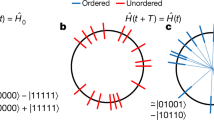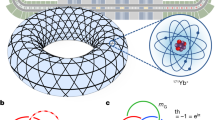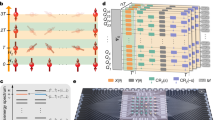Abstract
Nascent platforms for programmable quantum simulation offer unprecedented access to new regimes of far-from-equilibrium quantum many-body dynamics in almost isolated systems. Here achieving precise control over quantum many-body entanglement is an essential task for quantum sensing and computation. Extensive theoretical work indicates that these capabilities can enable dynamical phases and critical phenomena that show topologically robust methods to create, protect and manipulate quantum entanglement that self-correct against large classes of errors. However, so far, experimental realizations have been confined to classical (non-entangled) symmetry-breaking orders1,2,3,4,5. In this work, we demonstrate an emergent dynamical symmetry-protected topological phase6, in a quasiperiodically driven array of ten 171Yb+ hyperfine qubits in Quantinuum’s System Model H1 trapped-ion quantum processor7. This phase shows edge qubits that are dynamically protected from control errors, cross-talk and stray fields. Crucially, this edge protection relies purely on emergent dynamical symmetries that are absolutely stable to generic coherent perturbations. This property is special to quasiperiodically driven systems: as we demonstrate, the analogous edge states of a periodically driven qubit array are vulnerable to symmetry-breaking errors and quickly decohere. Our work paves the way for implementation of more complex dynamical topological orders8,9 that would enable error-resilient manipulation of quantum information.
This is a preview of subscription content, access via your institution
Access options
Access Nature and 54 other Nature Portfolio journals
Get Nature+, our best-value online-access subscription
$29.99 / 30 days
cancel any time
Subscribe to this journal
Receive 51 print issues and online access
$199.00 per year
only $3.90 per issue
Buy this article
- Purchase on Springer Link
- Instant access to full article PDF
Prices may be subject to local taxes which are calculated during checkout


Similar content being viewed by others
Data availability
The data contained in the figures of the main text and the extended data are available for download at https://doi.org/10.5281/zenodo.6514878.
Code availability
The software used in this manuscript are available from the corresponding authors upon request.
References
Zhang, J. et al. Observation of a discrete time crystal. Nature 543, 217–220 (2017).
Choi, S. et al. Observation of discrete time-crystalline order in a disordered dipolar many-body system. Nature 543, 221–225 (2017).
Kyprianidis, A. et al. Observation of a prethermal discrete time crystal. Science 372, 1192–1196 (2021).
Mi, X. et al. Time-crystalline eigenstate order on a quantum processor. Nature 601, 531–536 (2022).
Randall, J. et al. Many-body localized discrete time crystal with a programmable spin-based quantum simulator. Science 374, 1474–1478 (2021).
Friedman, A. J., Ware, B., Vasseur, R. & Potter, A. C. Topological edge modes without symmetry in quasiperiodically driven spin chains. Phys. Rev. B. 105, 115117 (2022).
Pino, J. M. et al. Demonstration of the trapped-ion quantum CCD computer architecture. Nature 592, 209–213 (2021).
Harper, F., Roy, R., Rudner, M. S. & Sondhi, S. Topology and broken symmetry in Floquet systems. Annu. Rev. Condens. Matter Phys. 11, 345–368 (2020).
Else, D. V., Ho, W. W. & Dumitrescu, P. T. Long-lived interacting phases of matter protected by multiple time-translation symmetries in quasiperiodically driven systems. Phys. Rev. X 10, 021032 (2020).
Abanin, D. A., Altman, E., Bloch, I. & Serbyn, M. Colloquium: many-body localization, thermalization, and entanglement. Rev. Mod. Phys. 91, 021001 (2019).
Sanders, Y. R., Wallman, J. J. & Sanders, B. C. Bounding quantum gate error rate based on reported average fidelity. New J. Phys. 18, 012002 (2015).
Dumitrescu, P. T., Vasseur, R. & Potter, A. C. Logarithmically slow relaxation in quasiperiodically driven random spin chains. Phys. Rev. Lett. 120, 070602 (2018).
Kumar, A., Dumitrescu, P. T. & Potter, A. C. String order parameters for one-dimensional Floquet symmetry protected topological phases. Phys. Rev. B. 97, 224302 (2018).
von Keyserlingk, C. W., Khemani, V. & Sondhi, S. L. Absolute stability and spatiotemporal long-range order in Floquet systems. Phys. Rev. B. 94, 085112 (2016).
Bahri, Y., Vosk, R., Altman, E. & Vishwanath, A. Localization and topology protected quantum coherence at the edge of hot matter. Nat. Commun. 6, 7341 (2015).
Affleck, I., Kennedy, T., Lieb, E. H. & Tasaki, H. in Condensed Matter Physics and Exactly Soluble Models (eds Nachtergaele, B. et al.) 249–252 (Springer, 2004).
Haldane, F. D. M. Nonlinear field theory of large-spin Heisenberg antiferromagnets: semiclassically quantized solitons of the one-dimensional easy-axis Néel state. Phys. Rev. Lett. 50, 1153–1156 (1983).
Huse, D. A., Nandkishore, R., Oganesyan, V., Pal, A. & Sondhi, S. L. Localization-protected quantum order. Phys. Rev. B. 88, 014206 (2013).
von Keyserlingk, C. W. & Sondhi, S. L. Phase structure of one-dimensional interacting Floquet systems. I. Abelian symmetry-protected topological phases. Phys. Rev. B. 93, 245145 (2016).
Else, D. V. & Nayak, C. Classification of topological phases in periodically driven interacting systems. Phys. Rev. B. 93, 201103 (2016).
Potter, A. C., Morimoto, T. & Vishwanath, A. Classification of interacting topological Floquet phases in one dimension. Phys. Rev. X. 6, 041001 (2016).
Roy, R. & Harper, F. Abelian Floquet symmetry-protected topological phases in one dimension. Phys. Rev. B. 94, 125105 (2016).
Po, H. C., Fidkowski, L., Morimoto, T., Potter, A. C. & Vishwanath, A. Chiral Floquet phases of many-body localized bosons. Phys. Rev. X. 6, 041070 (2016).
Po, H. C., Fidkowski, L., Vishwanath, A. & Potter, A. C. Radical chiral Floquet phases in a periodically driven Kitaev model and beyond. Phys. Rev. B. 96, 245116 (2017).
Treinish, M. et al. Qiskit v.0.27.0 (qiskit.org, 2021).
Acknowledgements
We thank Y. Zhang and M. Foss-Feig for discussions, as well as D. V. Else, A. J. Friedman, W. W. Ho and B. Ware for previous collaboration on this topic. We thank the entire Quantinuum team for their many contributions. This work was supported by National Science Federation Convergence Accelerator Track C award no. 2040549 (A.C.P.), the US Department of Energy, Office of Science, Basic Energy Sciences, under Early Career award no. DE-SC0019168 (R.V.), and the Alfred P. Sloan Foundation through Sloan Research Fellowships (R.V. and A.C.P.). This research was undertaken thanks, in part, to funding from the Max Planck-UBC-UTokyo Center for Quantum Materials and the Canada First Research Excellence Fund, Quantum Materials and Future Technologies Program (A.C.P.). The Flatiron Institute is a division of the Simons Foundation. Numerical simulations were performed in part on the Lonestar5 supercomputing system at the Texas Advanced Computing Center at the University of Texas, Austin.
Author information
Authors and Affiliations
Contributions
J.G.B., J.P.G., A.H., D.H. and B.N. all contributed to the experimental design, construction and data collection. P.T.D., A.K., R.V. and A.C.P. contributed to the theory, quantum circuit design and data analysis. All authors contributed to this manuscript.
Corresponding authors
Ethics declarations
Competing interests
The authors declare no competing interests.
Peer review
Peer review information
Nature thanks Guido Pagano and the other, anonymous, reviewer(s) for their contribution to the peer review of this work.
Additional information
Publisher’s note Springer Nature remains neutral with regard to jurisdictional claims in published maps and institutional affiliations.
Extended data figures and tables
Extended Data Fig. 1
Circuit compilation. Compilation of two-qubit operations into hardware-native gates for (a) the FSPT model (Fig. 2), and (b) the EDSPT model (Fig. 1). XXθ gates are obtained from a single-qubit basis rotation of ZZθ gates. Here, a line with two dots indicates a controlled-Z gate with unitary: \({u}_{{C}_{Z}}={e}^{-i\pi /4(1+{\sigma }^{z})\otimes (1+{\sigma }^{z})}\), and single qubit gates are listed as Pauli rotations with unitary \({u}_{X,{Y}_{\theta }}={e}^{-i\frac{\theta }{2}{\sigma }^{x,y}}\).
Extended Data Fig. 2 Disorder resolved EDSPT.
Data for edge qubits (top row) and site-averaged bulk qubits (bottom row) for the EDSPT protocol at J = 0.95π (Fig. 1). The different curves correspond to different static disorder realizations of Ki,α and Bα,i. Disorder d0 is performed on the H1-1 quantum device, whilst the other disorders are performed on the newer H1-2 device. See Methods for the differences between these devices. The H1-2 data (disorder averaged) was shown in Fig. 1a. The edge state data for single disorder d0 was shown in Fig. 1b, to compare with other J data taken on the same device.
Extended Data Fig. 3 Global qubit frequency calibration error.
(a) Histogram of the observed difference between the calibrated qubit frequency and the last known good calibration for each of the three ion trap gate zones: G2, G3, and G4. (b) Time-series of same data. These errors arise due to combination of background drifts in the magnetic field environment and statistical error in the actual qubit frequency calibration. For the data detailed in this paper, we observe a global RMS frequency error of ±0.5(1) Hz. Outliers are filtered (dashed line) for points greater than 4x the standard deviation to better capture the average behaviour of this error source.
Extended Data Fig. 4 FSPT Simulation with Coherent Error –.
Classical simulations of the FSPT in the presence of a coherent error of the form Eq. (3) in addition to depolarizing noise. Here, we perform 50 different coherent error realizations, with 104 measurement shots for each. The dark lines indicate the error averaged result for each site i, the pale line is an example of single coherent error realization. The parameters tlayerδf[xi] are drawn from a Gaussian distribution of standard deviation 0.025 and are approximated to be constant in time.
Extended Data Fig. 5 Loschmidt flux echo (ED Simulations).
Exact diagonalization (ED) simulations of the Loschmidt flux echo, \({\mathscr{Z}}(t)\), for the Floquet model with L = 9 for J = 0.9π in the FSPT phase (blue dots) where it exhibits saturating period-two oscillations, J = 0.5 in the thermal phase (purple diamonds) where \({\mathscr{Z}}(t)\) immediately averages to zero, and for J = 0.1π in a trivial MBL phase (orange, triangles) where \({\mathscr{Z}}(t)\) saturates to a non-oscillating value. Each point is averaged over all initial states and 100 disorder realizations.
Extended Data Fig. 6 Loschmidt flux echo.
(a) Interferometric protocol for measuring the Loschmidt flux-echo, \({\mathscr{Z}}(t)\): controlled evolution and measurement of an ancilla a (shown here in red) enables measurement of the overlap between time evolved states with and without a symmetry flux inserted. (b) Circuit for implementing the ancilla-controlled flux insertion. (c) Simulated and experimental data for the Loschmidt flux echo in the Floquet model with J = 0.9π (top panel) in the FSPT phase, J = 0.1π (bottom left panel) in the trivial MBL phase, and J = 0.5π (bottom right panel) in the thermalizing phase. For ideal noiseless simulations (pale line, simulation), symmetry-preserving MBL \({\mathscr{Z}}(t)\) exhibits persistent period-two oscillations in the FSPT phase, saturates to a constant value in the trivial MBL phase, and rapidly decays in the thermalizing phase. For weakly-open but symmetry-preserving MBL systems (dashed line, simulation) the oscillation or saturation amplitude slowly decays due to incoherent errors. By contrast, the experimental data strongly deviates from the symmetric simulations after \(t\gtrsim 5\) Floquet periods due to coherent errors. Experimental data shown for trivial-MBL and thermal include only ten shots, and were taken for a different disorder realization than the FSPT data.
Extended Data Fig. 7 Slow heating (numerical simulations).
Numerical simulations of the long-time behaviour of \(|{C}_{z}|\) for the edge qubit of an L = 10 qubit-chain with the Fibonacci drive, for various J (other parameters chosen as in Fig. 1). Each point is averaged over 960 disorder realizations. The inset shows estimate of heating time th empirically defined as the time when \(|{C}_{z}|\) drops below a small threshold ε = 0.02 (dashed line), and demonstrates that the three-fold periodic oscillations persist to timescale exponentially long in the inverse pulse detuning, \({|J-\pi |}^{-1}\).
Extended Data Fig. 8 Ideal FSPT implementation (short times).
FSPT model simulation (noiseless: pale solid lines, noisy: dashed lines) and experimental data (solid points with error bars) at the ideal J = π “fixed-point”. At these short times t ≤ 15, coherent errors have not yet affected the topological edge qubits. The edge shows the expected period-two oscillations, whereas bulk qubits show slowly decaying, weakly-open MBL behaviour along the symmetry axis ∼σx, and rapidly dephase due to random fields and qubit-qubit interactions perpendicular to the symmetry axis, ∼σz.
Extended Data Fig. 9 EDSPT with uniaxial disorder.
(a) Edge and (site averaged) bulk correlators for various values of J for the EDSPT model with disorder that nominally has a microscopic \({{\mathbb{Z}}}_{2}\) symmetry \(({{\bf{B}}}_{i}\parallel \hat{y})\). This symmetry is broken in the implementation by the same coherent errors that decohere the FSPT edge states. The EDSPT behaviour is not harmed by these coherent errors and does not rely on this fine-tuned symmetry; it persists over a range of \(|\,J-\pi |/\pi \lesssim 0.25\). Pale lines show idealized (noiseless) simulations, dashed lines show simulations with depolarizing noise, and solid dots with 1σ-error bars are experimental data. (b) The same edge data for various J replotted on a single plot to facilitate comparison of curves with different pulse-weights.
Extended Data Fig. 10 EDSPT Site-resolved Correlators (with uniaxial disorder).
shown for each site \(i\in \{1,2,\ldots 10\}\) in the chain. Pale lines show idealized (noiseless) simulations, dashed lines show simulations with depolarizing noise, and solid dots with 1σ-error bars are experimental data. As described in the Methods section, even sites are prepared and measured in the z basis and odd sites in the x basis. Whereas edge sites (i = 1, 10) exhibit period-three oscillations in Fibonacci time, the bulk sites (2 ≤ i ≤ 9) undergo random, but slowly decaying oscillations characteristic of the slow dephasing dynamics of MBL. Upon disorder- and/or site- averaging these random oscillations wash out as presented in Extended Data Fig. 9.
Supplementary information
Supplementary Information
Supplementary methods and calculations that detail the relationship between the dynamic sequences studied to the standard AKLT chain, which present a method to detect FSPT order through many-body interferometry, and which explore the stability of quasiperiodically driven MBL and demonstrate the long time (meta)stability of recursively generated quasiperiodic drives and the theoretical emergence of the multiple time-translation symmetries.
Rights and permissions
About this article
Cite this article
Dumitrescu, P.T., Bohnet, J.G., Gaebler, J.P. et al. Dynamical topological phase realized in a trapped-ion quantum simulator. Nature 607, 463–467 (2022). https://doi.org/10.1038/s41586-022-04853-4
Received:
Accepted:
Published:
Issue Date:
DOI: https://doi.org/10.1038/s41586-022-04853-4
This article is cited by
-
Quantum many-body simulations on digital quantum computers: State-of-the-art and future challenges
Nature Communications (2024)
-
Continuous symmetry breaking in a trapped-ion spin chain
Nature (2023)
-
Benchmarking universal quantum gates via channel spectrum
Nature Communications (2023)
-
Quantum Advantage Seeker with Kernels (QuASK): a software framework to speed up the research in quantum machine learning
Quantum Machine Intelligence (2023)
Comments
By submitting a comment you agree to abide by our Terms and Community Guidelines. If you find something abusive or that does not comply with our terms or guidelines please flag it as inappropriate.



